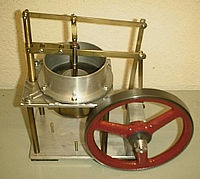
Photo from wikipedia
There is growing interest in heat pumps based on materials that show thermal changes when phase transitions are driven by changes of electric, magnetic or stress field. Importantly, regeneration permits… Click to show full abstract
There is growing interest in heat pumps based on materials that show thermal changes when phase transitions are driven by changes of electric, magnetic or stress field. Importantly, regeneration permits sinks and loads to be thermally separated by many times the changes of temperature that can arise in the materials themselves. However, performance and parameterization are compromised by net heat transfer between caloric working bodies and heat transfer fluids. Here we show that this net transfer can be avoided-resulting in true, balanced regeneration-if one varies the applied electric field while an electrocaloric (EC) working body dumps heat on traversing a passive fluid regenerator. Our EC working body is represented by bulk PbSc0.5Ta0.5O3 (PST) near its first-order ferroelectric phase transition, where we record directly measured adiabatic temperature changes of up to 2.2 K. Indirectly measured adiabatic temperature changes of similar magnitude were identified, unlike normal, from adiabatic measurements of polarization, at nearby starting temperatures, without assuming a constant heat capacity. The resulting high-resolution field-temperature-entropy maps of our material, and a small clamped companion sample, were used to construct cooling cycles that assume the use of an ideal passive regenerator in order to span $\leq$20 K. These cooling cycles possess well defined coefficients of performance that are bounded by well defined Carnot limits, resulting in large ($>$50%) well defined efficiencies that are not unduly compromised by a small field hysteresis. Our approach permits the limiting performance of any caloric material in a passive regenerator to be established, optimized and compared; provides a recipe for true regeneration in prototype cooling devices; and could be extended to balance active regeneration.
Journal Title: Physical Review X
Year Published: 2019
Link to full text (if available)
Share on Social Media: Sign Up to like & get
recommendations!